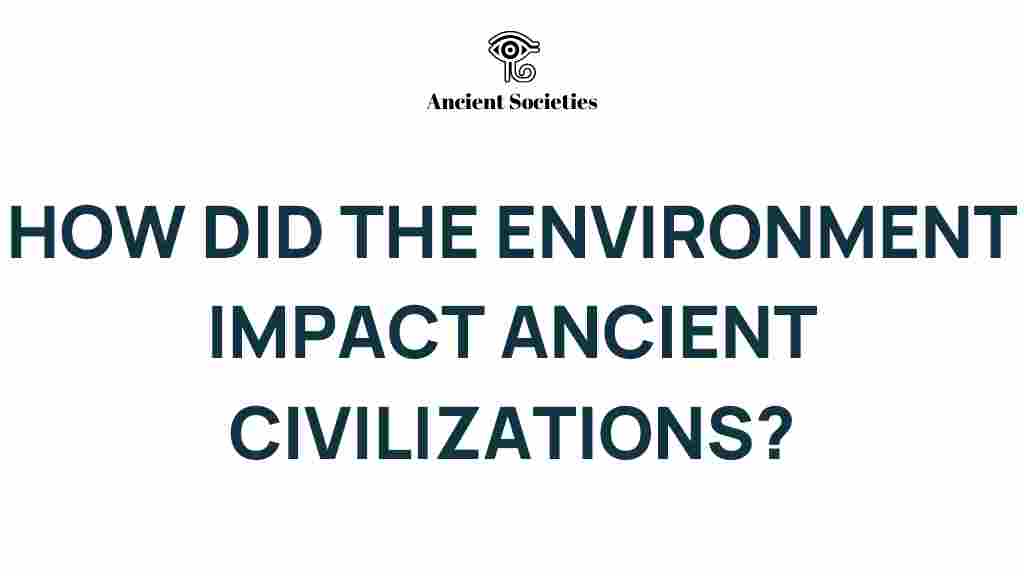Unraveling the Secrets: How Environment Shaped Ancient Civilizations
The intricate relationship between the environment and ancient civilizations has fascinated historians, archaeologists, and scientists for centuries. The **environment**—encompassing climate, geography, and available resources—played a pivotal role in the development of societies, shaping their agriculture, cultural evolution, and societal structures. This article delves into how the environment influenced ancient civilizations, highlighting the impact of climate change and resource management practices.
The Role of Geography in Shaping Civilizations
Geography is a fundamental aspect of how ancient civilizations evolved. The physical landscape dictated where people could settle, grow food, and engage in trade. Key geographical features include:
- Rivers: Rivers provided water for drinking and irrigation, facilitating agriculture. Civilizations like the Egyptians along the Nile and the Mesopotamians between the Tigris and Euphrates flourished due to these water sources.
- Mountains: Mountain ranges can create barriers that protect civilizations from invasions but also limit trade and communication.
- Deserts: Deserts often hindered movement and trade, leading to isolated cultures but also encouraging innovation in resource management.
These geographical elements not only influenced settlement patterns but also determined the resources available for agriculture and construction, shaping societal development.
Climate Change and Its Impact on Ancient Societies
Climate change has always been a natural phenomenon, impacting agriculture and the viability of civilizations. Ancient peoples faced climatic shifts that forced them to adapt or abandon their lands. Key examples include:
- The Fall of the Maya: Evidence suggests that prolonged drought conditions contributed to the collapse of the Maya civilization, affecting agricultural productivity and leading to societal strife.
- The Akkadian Empire: The Akkadian civilization in Mesopotamia faced severe droughts, which are believed to have caused resource scarcity and societal collapse.
Understanding how ancient civilizations responded to climate change provides valuable insights into modern challenges. Their strategies for adaptation and resilience can inform contemporary approaches to current climate issues.
Agriculture: The Foundation of Societal Development
Agriculture is often considered the cornerstone of civilization. The shift from nomadic lifestyles to settled farming communities marked a significant turning point in human history. Different environments fostered varied agricultural practices:
- Fertile Plains: Regions with rich soil, such as the Nile Delta, enabled the cultivation of surplus crops, leading to population growth and urbanization.
- Terracing: In mountainous regions, civilizations developed terracing techniques to maximize arable land, as seen in the Incan Empire.
- Irrigation: In arid regions, advanced irrigation systems allowed civilizations like the Sumerians to thrive despite limited rainfall.
The development of agriculture not only provided food but also allowed for the specialization of labor, leading to technological advancements and the emergence of complex societal structures.
Resource Management: Ensuring Sustainability
Effective resource management became crucial for the survival of ancient civilizations. The way they utilized their environment often determined their longevity:
- Water Management: Civilizations like the Harappans in the Indus Valley developed sophisticated drainage and water storage systems, showcasing advanced understanding of hydrology.
- Deforestation and Land Use: The Maya and other cultures faced challenges due to deforestation, leading to soil degradation and resource depletion.
- Trade Networks: Establishing trade routes allowed civilizations to share resources and mitigate local shortages.
Learning from these practices can help modern societies develop sustainable resource management strategies crucial for facing today’s environmental challenges.
Cultural Evolution Driven by Environmental Factors
The environment not only influenced agriculture and resource management but also played a significant role in cultural evolution. Social structures, religious beliefs, and artistic expressions were often shaped by environmental factors:
- Religious Practices: Many ancient religions were closely tied to natural elements, with gods representing aspects of the environment, such as agriculture or water.
- Art and Architecture: The availability of materials influenced artistic expression and building techniques. For instance, the use of mud bricks in Mesopotamian architecture was a direct response to local resources.
- Social Hierarchies: As societies grew, the management of resources often led to the establishment of ruling classes, affecting social dynamics.
Understanding these cultural evolutions provides insight into how societies adapt their identities in response to their environments.
Step-by-Step Process: How Environment Influences Civilization Development
To better understand the connection between the environment and ancient civilizations, we can outline a step-by-step process:
- Geographical Assessment: Identify the geographical features of the region, including rivers, mountains, and plains.
- Climate Analysis: Examine historical climate data to understand the environmental conditions during the civilization’s peak.
- Agricultural Practices: Investigate the agricultural methods employed and how they adapted to the environment.
- Resource Management Strategies: Analyze how resources were managed, including water, raw materials, and trade practices.
- Cultural Developments: Explore how the environment influenced cultural, religious, and social structures.
This systematic approach allows for a comprehensive understanding of how the environment shaped ancient civilizations.
Troubleshooting Tips: Analyzing Historical Environmental Impact
When researching the environmental impact on ancient civilizations, consider the following tips:
- Diverse Sources: Use a variety of sources, including archaeological evidence, historical texts, and climate data, for a well-rounded perspective.
- Interdisciplinary Approach: Collaborate with experts in environmental science, archaeology, and history to gain deeper insights.
- Contextual Analysis: Always consider the broader context, including trade relationships and external influences that may have affected the civilization.
By following these tips, researchers can avoid common pitfalls and develop a clearer understanding of the intricate relationship between environment and civilization.
Conclusion
The environment profoundly shaped ancient civilizations, influencing their agriculture, societal development, resource management, and cultural evolution. By studying these relationships, we gain valuable insights into the resilience and adaptability of human societies. As we face contemporary challenges like climate change, the lessons learned from ancient civilizations can guide us in developing sustainable practices for the future.
To explore more about how ancient civilizations adapted to their environments, check out this in-depth resource. For additional insights into climate change’s effects on society, visit this external link.
As we unravel these secrets, we not only honor the past but also equip ourselves for a sustainable future.
This article is in the category History and created by AncientSocieties Team
